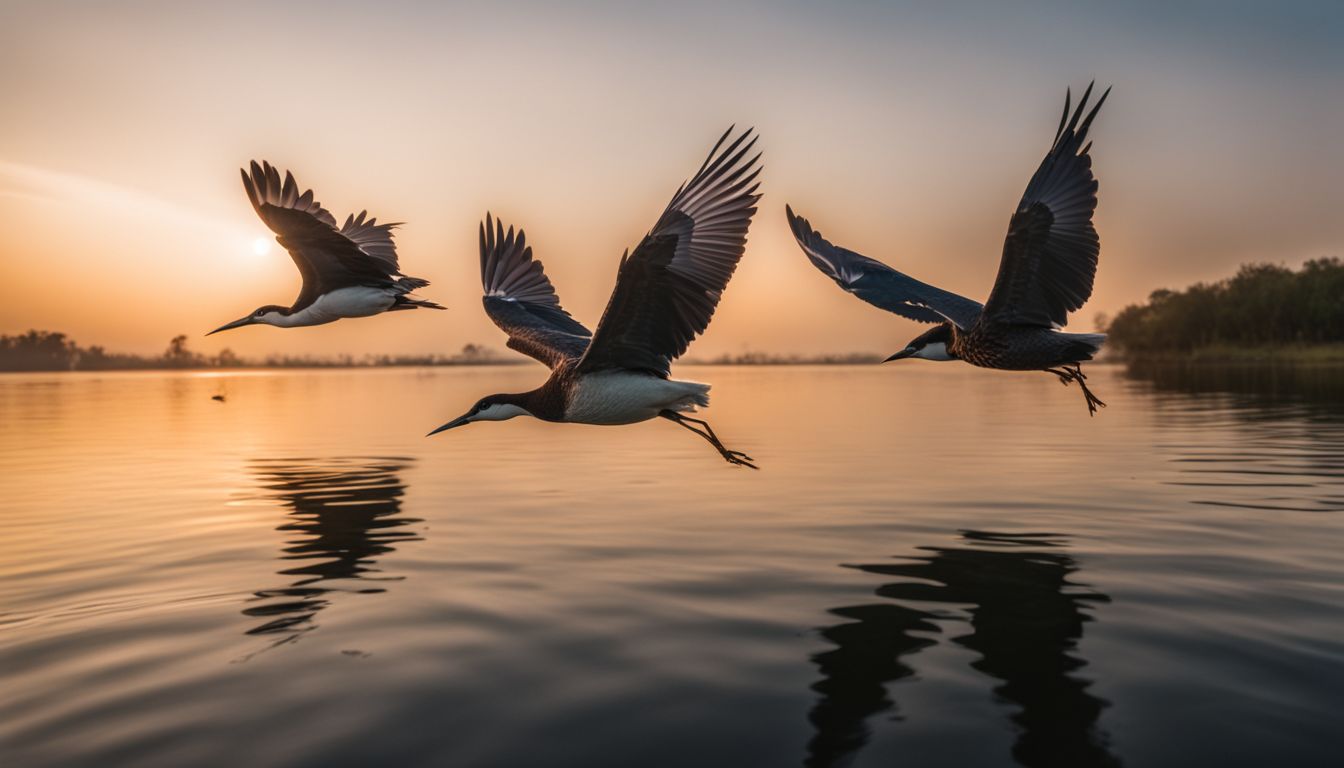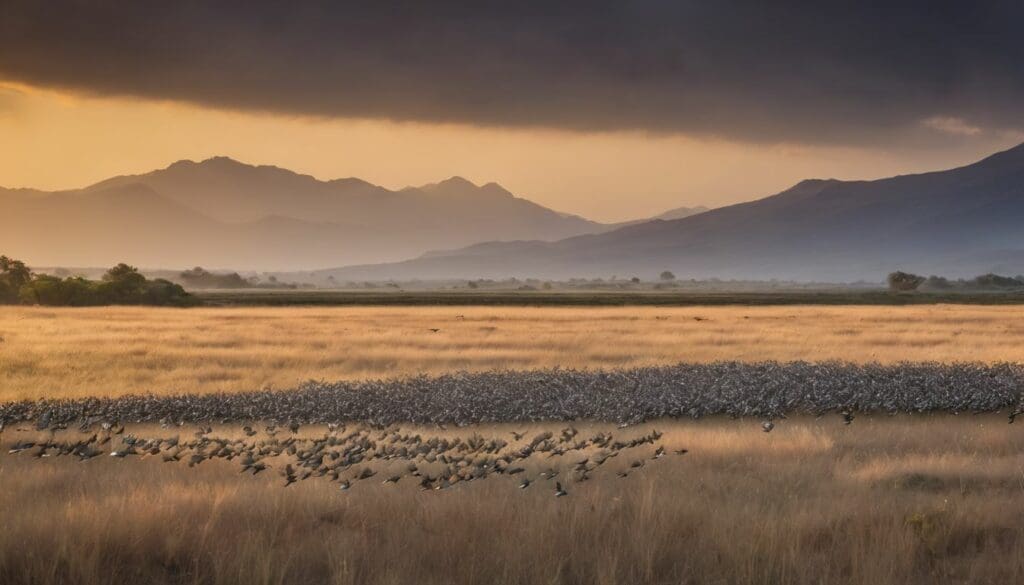Many of us can’t help but feel a twinge of sadness as we’ve observed the skies growing quieter, with fewer birds tracing their ancient flyways above. It’s a genuine concern that resonates deep within our birdwatching communities and beyond—after all, these creatures are part of our shared natural heritage.
Armed with a keen awareness that climate change may well be reshaping migratory patterns, we’ve committed to unravelling this complex tapestry. In this article, we shall illuminate the trials and tribulations faced by our feathered voyagers in an increasingly warm world.
Join us as we delve into their astounding acts of resilience and adaptability — marvelling at how they ingeniously plot their course across a globe in flux.
Key Takeaways
- Migratory birds use the Earth’s magnetic field and celestial cues like the sun and stars for navigation during their long-distance journeys.
- Climate change is impacting migratory patterns, causing shifts in timing, temperature stress, vegetation changes and habitat loss, leading to population declines in bird species.
- Birds are adapting to these changes by altering migration times and routes, breeding in new areas, changing diets and elevations to cope with fluctuating temperatures.
- Large – scale climate patterns such as Rossby waves influence bird migration paths; changes in these can affect the timing of migrations.
- Research into bird navigation hints at a possible connection with quantum physics through mechanisms like avian magnetoreception involving proteins called cryptochromes.
Understanding Bird Migration

Delving into the world of bird migration unveils an intriguing journey, where feathered travellers navigate vast distances with remarkable precision. We’re on a quest to decode how these avian adventurers chart their courses across continents and oceans, guided by the stars above and the earth’s magnetic whispers beneath their wings.
The Mystery of Bird Navigation
We often stand in awe of migratory birds that navigate thousands of miles to reach their breeding grounds or winter havens. They rely on the Earth’s magnetic field as a compass, guiding them along their epic journeys with precision and consistency.
Scientists believe these creatures possess an innate ability called magnetoreception, allowing them to detect magnetic fields and use this sense for orientation.
Birds also tap into environmental cues like the sun during the day and stars at night to maintain their migration routes. By reading the sky patterns and using their internal biological clock, they adjust flight paths as needed.
This phenomenal capability showcases nature’s intricate design, leaving us fascinated by how migrating birds accomplish such feats without maps or instruments—only with sharp instincts honed through millennia of evolutionary adaptation.
The Role of Celestial Cues
Birds rely on celestial cues to guide their epic journeys across continents and oceans. They use the sun during the day, and at night they navigate by stars. This celestial compass helps them find their way even when flying over vast, featureless expanses like the open sea where landmarks are non-existent.
As dusk falls, night-migrating species wait for constellations to appear before setting off. This reliance on stellar patterns links them intimately with the rhythms of our planet’s rotation and orbit around the sun.
Their astronomical skills ensure they reach breeding grounds or winter havens as environments shift due to climate change. Moving onto how these shifts impact bird migration throws light on pressing issues we must address in habitat conservation efforts.
The Impact of Climate Change on Bird Migration

Climate change is casting a shadow over the intricate dance of migratory birds, thrusting unpredictable patterns upon their age-old journeys. We’re witnessing how rising temperatures and shifting seasons are forcing these winged navigators to adapt or face stark declines, reshaping our natural world in profound ways.
Population Declines in Migratory Bird Species
Migratory bird species face daunting challenges due to changing climate patterns. As temperatures shift, traditional habitats alter, directly impacting food availability for these birds.
Many species, such as the bar-tailed godwit and the arctic tern, must travel thousands of miles between breeding ranges, relying on specific stopover sites to rest and refuel. But these crucial areas are disappearing or becoming less hospitable because of global warming and rising sea levels.
We’re witnessing a troubling trend where once-thriving flocks now dwindle in numbers each passing year. Habitats like salt marshes vital for roosting during long migrations shrink under the threat of encroaching seas.
Furthermore, unusual weather patterns disrupt migration timing, leading birds to arrive too early or too late in their breeding range, missing out on essential resources needed for survival and reproduction.
Conservationists are racing against time to understand how best we can protect these migratory species from further decline amidst rapid climatic change.
Disruption of Migration Timing
Climate change alters the delicate balance of nature’s calendar and this throws migratory patterns into disarray. As global average temperatures rise, birds start their journeys earlier or delay their departures, struggling to time their flights with food availability.
Warmer springs prompt insects to hatch sooner while plants bud early; if migratory birds misjudge these cues, they may arrive at breeding grounds when resources are scarce.
We see a growing mismatch between peak food demand and supply across various ecosystems, impacting not only the migrating birds but also the health of habitats as a whole. This untimely disruption forces species to adapt rapidly or face severe declines in population numbers.
For instance, seabirds that rely on fish might find themselves out of sync with fish spawning events due to warmer oceans. These changes put extra pressure on us to find ways to mitigate climate impacts and safeguard these vital migration routes for future generations.
Temperature Stress and Shifting Vegetation
As temperatures rise, birds face serious stress. They rely on specific conditions to thrive and any shift can throw their world out of balance. Heatwaves and cold spells force them to expend more energy just to survive, putting a strain on their bodies that affects everything from feeding patterns to breeding success.
Vegetation changes in response to these temperature fluctuations create another hurdle for migrating species. Plants may bloom earlier or not at all, altering the availability of food along migration routes.
Birds must then adapt quickly, finding new sources of sustenance or changing their travel plans entirely. This disruption impacts species distribution with some areas becoming unsuitable habitats while others may turn into unexpected oases.
We now turn our attention towards the innovative strategies birds have adapted in order to navigate this unpredictable climate landscape.
Strategies Birds Have Developed to Cope with Climate Change
Our feathered friends face climate challenges head-on, adapting in remarkable ways. They’ve developed strategies to survive as the earth’s climate undergoes significant changes.
- Birds adjust their migration patterns, departing earlier or later to sync with shifting seasons. This helps them take advantage of favourable conditions for breeding and feeding.
- Species such as the common cuckoo have been spotted using different routes, minimising the energy used by avoiding extreme weather affected by climate changes.
- Some birds stay put instead of migrating long distances. They save energy and reduce risks like getting lost or running out of food.
- A number of species now breed in new areas where the temperature is more suitable for raising their chicks. They’re seeking habitats that match their historical nesting grounds in terms of food supply and shelter.
- Others have shown an incredible ability to alter their diet. With traditional food sources becoming unreliable, they switch to what’s available, sustaining themselves through tough times.
- There are avian populations that shift elevation, usually heading higher up where it’s cooler when lowlands become too warm.
- Birds also utilise magnetoreceptors in their eyes for navigation, aligning themselves with changes in the earth’s magnetic field even as it fluctuates due to climate change.
- Many species have adapted timing for egg – laying. Laying eggs earlier lets them align with the peak availability of resources needed for breeding success.
The Connection Between Bird Migration and Large-Scale Climate Patterns
As we consider the adaptability of birds to climate change, it’s crucial to explore how their migration patterns are intricately linked to large-scale climate rhythms. Birds time their travels with remarkable precision, often syncing with weather systems and capitalising on favourable winds.
For instance, Rossby waves – massive undulations in high-altitude winds that circle the globe – can create pathways that assist migratory birds during their long journeys. These natural highways in the sky allow them to conserve energy, essential for surviving epic transcontinental flights.
Migratory routes also closely follow shifts in sea surface temperatures and vegetation changes driven by global climate cycles. Changes in these environmental factors can trigger birds to start their migration.
For example, an early spring thaw might prompt a wave of migrants eager to exploit newly accessible food resources. Conversely, unexpected cold snaps or extreme weather events caused by human-induced climate change can throw these delicate timings off balance, posing challenges for bird populations as they seek out hospitable climates and feeding grounds en route to breeding territories or winter refuges.
Scientific Theories on Bird Navigation
Delving into the scientific theories on bird navigation leads us down a fascinating path where instinct intertwines with the cutting-edge of quantum mechanics. Our feathered friends might just be tapping into a world beyond our senses, navigating by mechanisms that challenge our understanding of biology and physics alike.
The Use of Landmarks and Stars
We often marvel at how birds undertake breathtaking journeys across continents, but their secret lies in using landmarks and stars as guides during migration. They have a remarkable ability to recognise distinctive features of the landscape, like mountains, rivers, or coastlines, which serve as signposts on their long-distance trips.
At night, many species look up to the sky and read stellar patterns to keep them flying in the right direction.
These avian navigators also tap into Earth’s magnetic field for orientation. Their innate magnetic sense is similar to an internal compass leading them over vast stretches of open water or unshielded terrain where landmarks are scarce.
Studies suggest that certain molecules in birds’ eyes might help them visualise magnetic fields as patterns of light or darkness overlaid on their normal vision – allowing them to stay on course even when stars are obscured by clouds.
The Potential Role of Quantum Physics
Quantum physics might seem far removed from the flight patterns of birds, but recent studies suggest a fascinating link between the two. Birds, like the ruby-throated hummingbird and luscinia luscinia, could be using something known as quantum entanglement to navigate during their long-distance migrations.
Quantum entanglement involves particles that remain connected so that actions performed on one affect the other, no matter how great the distance separating them.
Scientists are exploring how birds may rely on a process called avian magnetoreception to sense Earth’s magnetic field. This remarkable ability could involve reactions within proteins called cryptochromes, found in bird’s eyes.
These proteins might form pairs of radicals when they absorb a photon; such pairs enter into what we call singlet and triplet states wherein their electrons have opposite or same spin angular momentums respectively.
The orientation of these spins relative to Earth’s magnetic field could give migrating birds all the directional information they need.
As we consider these incredible navigational strategies, our next focus lies on understanding ‘Lessons Learned from Migrating Birds in Managing Climate Change’.
Lessons Learned from Migrating Birds in Managing Climate Change
We observe how migrating birds adapt their routes and schedules in response to climate shifts, reminding us of the importance of flexibility. Just like these feathered navigators, we need to adjust our conservation strategies as conditions change.
They teach us that timing is crucial; many species now breed earlier or migrate at different times to stay in sync with food availability. From them, we learn the value of observance and action.
Migrating birds also show incredible resilience by seeking out new habitats as old ones become unsuitable due to rising sea levels or changing temperatures. We take inspiration from their ability to find alternative solutions when traditional paths are blocked.
Emulating these avian pioneers, we work towards creating migratory corridors and protecting critical stopover sites that can support bird populations amid the effects of climate change.
Their instinctive drive to survive encourages us in our own quest for innovative ways to combat environmental challenges.
Conclusion
In wrapping up, let’s recognise the resilience of migratory birds as they face climate change head-on. These winged navigators adapt to a planet in flux, reminding us of nature’s remarkable ability to endure.
Our ongoing research enriches our understanding and guides conservation efforts. Together, we can work towards safeguarding their aerial odysseys for future generations. Let’s take inspiration from their journeys and commit to protecting our shared skyways.
FAQs
1. How does climate change affect migratory birds?
Climate change impacts migratory birds by altering their habitats, changing food availability and causing sea levels to rise, which can disrupt their traditional migration paths.
2. What are magnetic moments and how do they help birds migrate?
Magnetic moments relate to the atomic-level properties that allow birds to sense Earth’s magnetic field through a process involving molecules like cry1 and magnetite in their photoreceptors, helping them navigate during migration.
3. Are changes in climate creating challenges for long-distance migrants?
Yes, long-distance migrant birds face significant challenges due to shifts in geography and conditions caused by climate change, such as altered timing of food sources and breeding grounds.
4. Could rising greenhouse gases influence bird migrations?
Rising greenhouse gases contribute to changes in climate that may lead migrates to alter their patterns due to temperature fluctuations and extreme weather events linked with increased atmospheric carbon.
5. How might fluctuating sea levels impact shorelines that many species rely on?
Fluctuation of sea levels can erode or submerge important shoreline habitats endangering the survival of species dependent on these areas for nesting or feeding during migration routes.
6. Can scientists make testable predictions about how migratory behaviors will adapt?
Scientists use data about circadian rhythms, chemical intermediates involved in sensing like FAD (flavin adenine dinucleotide), along with knowledge of three-dimensional structures within bird navigational systems to form testable predictions on future migratory adjustments.





